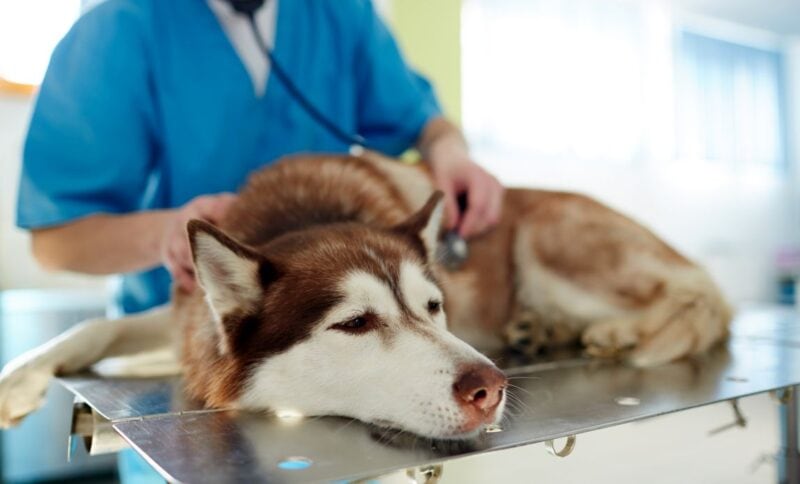Few things are as unnerving as encountering a seizing dog. The sheer helplessness of the moment is something you never forget.
Sadly, seizures, while terrifying, aren’t terribly rare in dogs. In fact, they’re one of the most common canine neurological disorders.
The good news is seizures don’t necessarily spell doom for your dog. Still, first-aid intervention is required for seizures along with prompt veterinary care.
We’ll share the ins and outs of canine seizures and explain how to safely navigate this veterinary emergency below.
Seizures in Dogs: Key Takeaways
- A canine seizure is caused by uncontrolled electrical activity in a dog’s brain. This disruption can occur for many reasons, including blood sugar imbalances, kidney disease, and more.
- Veterinary care is critical in treating and preventing canine seizures. Prompt treatment addresses any lingering effects from the seizure and can help determine the cause, potentially preventing future seizure activity.
- Some breeds are more likely to suffer from seizures than others. While any purebred or mixed breed can suffer from seizures, some breeds are more genetically predisposed to them, including Belgian Tervurens, beagles, and more.
What Are Seizures in Dogs?

A seizure occurs when uncontrolled electrical activity occurs between your dog’s brain cells. Your dog’s reaction to this disruption varies by type of seizure, with effects ranging from a temporary change in behavior to uncontrolled, violent convulsions.
Seizures can be random, one-off events, or chronic conditions, making prompt veterinary care essential for a proper diagnosis and treatment.
Are There Different Types of Seizures in Dogs?
Seizures fall into different classifications, depending on what region of your dog’s brain is affected. The two major groupings of canine seizures are:
- Focal: Also known as a partial seizure, this type only affects a region of half of the brain and causes more subtle symptoms, like dilated pupils, growling, muscular twitching, “fly-snapping” (which appears as though your dog is trying to catch a buzzing fly), or changes in hearing/seeing.
- Generalized: Also called grand mal, this kind of seizure involves both sides of the brain and triggers severe symptoms, including a loss of bladder or bowel control and unconsciousness in many cases.
Focal seizures are less obvious than generalized seizures, but this doesn’t necessarily make them less severe. They’re still signs of dysfunction in the brain and demand prompt treatment and diagnosis.
Generalized seizures are broken down further into several categories, including:
- Atonic: Causes a sudden loss of muscle control and collapse
- Tonic: Involves muscle contractions and stiffening
- Clonic: Consists of sudden, violent muscle contractions and jerking
- Tonic-clonic: A combination of a tonic phase followed by a clonic phase
- Myoclonic: Involves random jerking movements on both sides of the dog’s body
If your dog starts suffering from more than one seizure in a 24-hour period, your vet may classify them as “cluster” seizures.
But it’s important to note that they’re only considered cluster seizures if your dog fully regains consciousness and the symptoms subside between episodes. If your dog does not regain consciousness between seizures or experiences a seizure lasting more than five minutes, it’s called status epilepticus, which can be life-threatening.
Immediate veterinary care is required for both status epilepticus and cluster seizures.
But generally speaking, most seizures last seconds or, at most, a few minutes (less than five.) Always monitor your dog’s symptoms throughout a seizure episode to report to your vet later. While changes may seem subtle or insignificant, they can be a vital clue in your dog’s diagnosis.
What Does It Look Like When Your Dog Has a Seizure?

Unfortunately, canine seizures don’t all present the same way, so knowing what to look for is essential in detecting them. Some symptoms are far more subtle than others and can be harder to spot.
The most common symptoms of dog seizures are:
- Convulsions (shaking and trembling)
- Falling down
- Stiffening
- Sudden awkward gait or staggering
- Chattering of the teeth or tongue chewing
- Loss of consciousness
- Blindness
- Loss of hearing
- Disorientation
- Excessive drooling
- Raised hair
- Random limb movement
- Facial twitching
- A vacant gaze (staring at the wall)
- Loss of bladder/bowel control
- Behavior changes
- “Fly-snapping”
Just remember that you know your dog best. If something seems off about him, don’t shy away from telling your vet. It’s always better to err on the side of caution.
We’ve included a video below documenting two different dogs having seizures so that you’ll know what they look like.
But please understand, this is not an easy video to watch.
The dogs are scared and upset, the humans are scared and upset, and it’s just generally not the kind of thing you’d want to watch unnecessarily. Nevertheless, its educational value is clear, and it may be helpful for some readers.
What Exactly Happens During Dog Seizures?
While they vary a bit from one dog to the next, canine seizures progress in phases, including:
- The Pre-ictal Phase: This period precedes the seizure and may involve changes in your dog’s behavior, including restlessness, whining, drooling, or trembling. Your pup may hide, follow you around excessively, or pace. This can last for several seconds or a few hours.
- The Ictal Phase: Active seizing occurs during this phase, which can last for as few as several seconds or upwards of several minutes. The exact symptoms will vary by the seizure type, but your dog may exhibit mild signs, such as the vacant staring seen in focal seizures, or he may lose consciousness or convulse violently if the seizure is generalized.
- The Post-Ictal Phase: This phase occurs after seizing has stopped. Your dog may be temporarily disoriented, leading to pacing, staggering, or whining. He may drool excessively or have a hard time settling down. Temporary blindness may occur in dogs at times during the post-ictal phase. This can last up to 24 hours.
Knowing the phases of a seizure can help you detect one in your dog, especially if he has a known seizure disorder. Of course, some dogs mask discomfort better than others, but it’s still good to know the basics. It can also ease your anxiety over the situation and alert you to any odd changes.
What Causes Seizures in Dogs?
Seizures in dogs have a laundry list of potential causes, with some being far more serious than others, so it’s important not to panic and think the worst. In many cases, your veterinarian can diagnose the root cause and control the issue so your doggo can enjoy life.
The most common causes of seizures in dogs are:
- Epilepsy
- Heat exhaustion
- Head injury
- Blood sugar imbalance
- Medication side effects (especially heartworm preventatives)
- Brain tumor
- Electrolyte issues
- Heartworm infestation
- Infection
- Kidney disease
- Liver disease
- Ingestion of toxic or poisonous substances
Idiopathic epilepsy is the most common cause of canine seizures. This inherited disorder has no known cause and is most often found in purebred dogs, though any breed or mix can have it. While it sounds scary (and it certainly is when your dog is actively seizing,) epilepsy can be managed with medication.
Seizures occur most often in times of high excitement, such as during play, walks, or kennel stays. They may also occur around feeding time, first thing in the morning, or right before bed.
Note that the ingestion of something toxic can also lead to seizures. So, be sure to familiarize yourself with some of the other symptoms of poisoning in dogs.
What Should You Do When Your Dog Has a Seizure?

Knowing how to handle a seizure is not only important for keeping your dog safe but also a powerful tool in remaining calm when one occurs. You’re less likely to panic if you know what to expect and what to do.
If your dog is having a seizure:
Do:
- Take a deep breath. Seizures are scary, but now isn’t the time to freak out. Remain calm, stroke your dog’s fur (while staying away from your dog’s head to avoid getting bitten), and stay strong for your pup. You’ll get through this together.
- Talk calmly to your dog. Not only is this reassuring for him, but it can be for you too.
- Note your dog’s symptoms. Remember: No matter how insignificant they may seem, these can be vital clues in figuring out the cause of your dog’s seizure.
- Time the seizure. This is critical for diagnosis and also important in determining the need for immediate treatment in the event of status epilepticus. The longer your dog seizes, the more he’s at risk of overheating (hyperthermia.) This is a risk if the seizure lasts more than two to three minutes. To help cool your dog, apply a cool, wet cloth to his paws, neck, belly, and head.
- Move your dog to safety. Gently move your dog away from environmental hazards like stairs, water, or fireplaces while he’s seizing (or even better, move the objects away from your dog, when possible). This includes putting him on the floor if he’s on furniture.
- Monitor your dog. Even if the seizure is over, you need to keep a close eye on your dog for at least 24 hours to rule out cluster seizure activity.
- Take notes (or even better, film the seizure). Make sure to record your dog’s seizure, just in case you forget before seeing the vet. Detail the date, length, and time of the seizure, along with symptoms. Include any extras you can think of, too, no matter how insignificant it seems, whether it’s the new supplement your dog started that morning or the new park you visited for a walk. Sometimes this can clue you in on the seizure’s cause.
- Call your vet. Always notify your veterinarian of a seizure, even if your dog has a known disorder like epilepsy or seems fine afterward. For emergencies like seizures lasting longer than five minutes or cluster seizure events, bring your dog to the nearest emergency clinic for immediate care.
Do Not:
- Don’t put off treatment or try DIY solutions. Seizures can be veterinary emergencies. They aren’t something to “watch and wait out.” Always contact your vet when they occur.
- Don’t freak out. We know it’s hard, but your dog is depending on you to stay calm. He’s already in a state of panic. Don’t add to it.
- Don’t put anything (including your hand) in your dog’s mouth. You risk choking your dog or a severe bite in doing so. Don’t worry about him “swallowing his tongue,” that’s just an old myth.
- Don’t submerge your dog in water. This is kind of a no-brainer, but don’t dunk him in water, as is recommended in some of the less-reputable parts of the internet. This won’t “snap him out of it,” but it could cause him to drown.

Don’t be alarmed if your vet wants to do a full nose-to-tail inspection after a seizure, including blood tests to check your dog’s blood sugar, electrolytes, and organ health. Your vet is just trying to make sure your pup is OK and not suffering from a hidden illness.
Your vet will also look for signs of head trauma, poisoning, or heartworm disease if your pup isn’t up-to-date on his preventative.
Remember: Post-seizure care is as important as during the seizure itself. Your dog may be off-balance for a bit, so block off access to stairs, water, high furniture, etc. He may also want to eat or drink. If your vet gives the OK to eat and drink, you should let him, but keep a close eye on him. He may just want to sleep, too, so let him rest up while you sort things out with your vet.
Can Seizures Be Treated or Prevented?
Treating seizures depends on the root cause. In the event of poisoning, this may include pumping your dog’s stomach or flushing his system. Your dog may also be administered activated charcoal to absorb toxins present.
Underlying health conditions like diabetes or kidney disease require care to get the illness under control.
Seizures themselves are generally treated with medication if:
- Cluster seizures are detected
- Your dog has more than one seizure a month
- Your dog experiences a severe generalized seizure
If these occur, your veterinarian may prescribe a daily anticonvulsant medication (such as phenobarbital) that your dog will take for the rest of his life. It’s important to follow the instructions closely and never miss a dose, as your dog is at risk of more severe seizure activity in the future.
It’s also important to continue to work closely with your vet, as some medications will necessitate regular blood tests to ensure the medication is at a therapeutic level and that your dog’s liver isn’t struggling with the drugs.
Just understand that while epilepsy is scary, it isn’t a death sentence. Your dog can go on to live a happy, healthy life, even if he has some hiccups along the way.
As for preventing seizures, it starts with opting for an ethical breeder who performs health testing and monitors for hereditary disorders, such as epilepsy, kidney disease, and liver disease.
You may also want to skip kenneling and opt for in-home dog sitters if you’re going away, as the stress can sometimes trigger an episode.
Are Seizures Painful for Dogs?

Seizures are not painful for dogs, but they can be scary due to disorientation, hallucinations, and loss of body control. They can also lead to injuries if your dog falls while seizing. Always move him away from staircases, water, and other environmental hazards during a seizure. If he’s on the couch or bed, move him to the floor, so he doesn’t fall. If you can, gently slip a blanket or pillow under his head as a cushion so he doesn’t strike his head on the floor while convulsing.
While they’re not painful, seizures are still dangerous and should be investigated by your veterinarian. Cluster seizures and those lasting longer than five minutes (status epilepticus) require immediate veterinary care.
Which Dogs Are at Highest Risk of Seizures?
While any breed or mixed breed can suffer from seizures, some are sadly more at risk than others due to an inherited risk of idiopathic epilepsy, including:
- Belgian Tervuren
- Beagle
- Collie
- Australian shepherd
- Keeshond
- Shetland sheepdog
- Golden retriever
- Labrador retriever
This doesn’t mean every member of the breed will have seizures, but it makes finding a good dog breeder essential if you’re interested in these specific breeds.
Typically dogs suffering from idiopathic epilepsy start exhibiting signs between age one and five, and males are at an increased risk of developing epilepsy. That said, females can certainly develop epilepsy too. But fortunately, spaying your dog can help reduce the chances of her suffering seizures, as estrogen can increase the chances of seizures occurring.
***
Canine seizures are frightening, but you can get through them together with proper veterinary care and a level head.
We hope you and your doggo feel better soon.














Leave a Comment